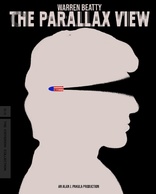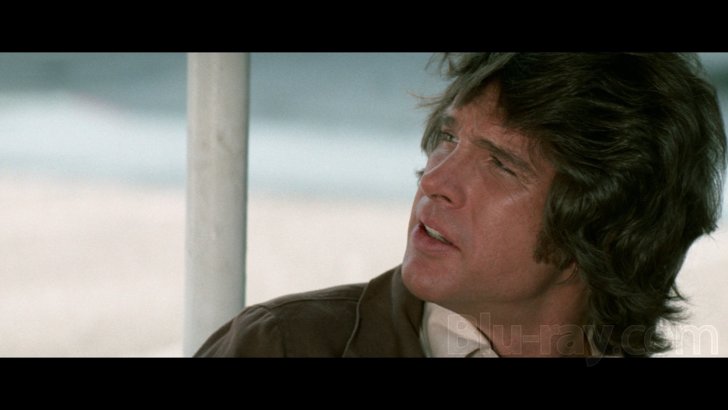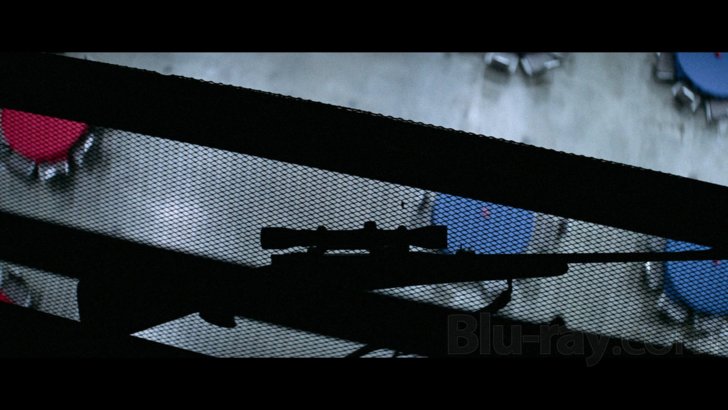The Parallax View Blu-ray Movie
HomeThe Parallax View Blu-ray Movie 
Criterion | 1974 | 102 min | Rated R | Feb 09, 2021
Movie rating
7.4 | / 10 |
Blu-ray rating
| Users | 4.0 | |
| Reviewer | 4.0 | |
| Overall | 4.0 |
Overview
The Parallax View (1974)
An ambitious reporter gets in way-over-his-head trouble while investigating a senator's assassination which leads to a vast conspiracy involving a multinational corporation behind every event in the world's headlines.
Starring: Warren Beatty, Paula Prentiss, William Daniels, Hume Cronyn, Earl HindmanDirector: Alan J. Pakula
| Drama | 100% |
| Film-Noir | 58% |
| Thriller | Insignificant |
| Mystery | Insignificant |
Specifications
Video
Video codec: MPEG-4 AVC
Video resolution: 1080p
Aspect ratio: 2.39:1
Original aspect ratio: 2.39:1
Audio
English: LPCM Mono (48kHz, 24-bit)
Subtitles
English SDH
Discs
Blu-ray Disc
Single disc (1 BD)
Playback
Region A (locked)
Review
Rating summary
| Movie | 4.0 | |
| Video | 5.0 | |
| Audio | 5.0 | |
| Extras | 3.0 | |
| Overall | 4.0 |
The Parallax View Blu-ray Movie Review
Reviewed by Dr. Svet Atanasov January 19, 2021Alan J. Pakula's "The Parallax View" (1974) arrives on Blu-ray courtesy of Criterion. The supplemental features on the disc include archival interview with the director; archival program with cinematographer Gordon Willis; new video interview with Jon Boorstin; and more. Also included with the release is an illustrated leaflet featuring an essay by critic Nathan Heller and an archival interview with the director, as well as technical credits. In English, with optional English SDH subtitles for the main feature. Region-A "locked".

Behind every conspiracy theory there is an unproven truth. This statement comes from a very smart man with whom years ago I spent a lot of time discussing all sorts of different political events. I understood exactly what he meant long after he passed away, and the older I get, the more convinced I become that he was absolutely correct.
The world was a very different place when we had our discussions. It was divided by the superpowers and as a result it was always easy to predict how the ‘other side’ will react to the latest political events the news networks covered. All you had to do was compare their contrasting points of view and form the 'right' opinion. Then you could get the whole truth, but you had to do the hard work of researching the facts. This process made perfect sense to me, and I never questioned its logic.
But everything changed during the 1980s when Mehmet Ali Agca attempted and failed to assassinate Pope John Paul II. This was a huge event that rocked the divided world and there was simply no way to avoid the drama that ensued immediately after it. Like everyone else at the time, I read as many articles as I could, and I watched the trial. Slowly but surely, I was assembling the truth. But the truth that emerged in the media -- starting with Agca’s past with the Gray Wolves to his possible involvement with Eastern European secret services to his supposedly flawless planning of the solo hit on Pope John Paul II -- made very little sense. And then it became flat-out ridiculous when, seemingly overnight, a lot of very powerful people declared that they had the evidence to conclude that Agca had acted entirely alone. At this point I knew that the official ‘truth’ was actually a convenient lie, just like the one explaining Lee Harvey Oswald’s heinous act in Dallas. It was when I first began to wonder whether researching the facts was enough to get the truth. What if the facts were manufactured, or as my friend used to say ‘doctored’, to help even the hopelessly curious ones assemble a very particular truth?
Some years later, after the Cold War had officially ended, I began to understand what my friend’s statement was meant to convey. Until then, I had always assumed that the emphasis in the statement was on the unproven truth validating all of the events that would spawn a conspiracy theory. But I was wrong, because I was taught to define everything in absolute terms. Indeed, once it dawned on me that even the most outrageous conspiracy theories have a factual starting point, the logic of my friend’s statement became impossible to dismiss. Take a moment and think about it. Just a tiny fraction of this factual starting point can be expanded to qualify as the unproven truth, and when placed in a proper context it could be earth-shattering. The nature of the conspiracy theory then no longer matters and neither do its conclusions, because the expansion of the starting point has suddenly compromised a lot of what you have been conditioned to believe in.
Alan J. Pakula’s The Parallax View does precisely what I described to you above -- it slightly expands the factual starting point of a pretty outrageous conspiracy theory to help you see past events from an entirely new angle. Predictably, the structure of the conspiracy theory and the exact order in which its ‘truths’ are revealed are again utterly pointless. It is why when the final credits roll you will have a lot more questions than answers to contemplate.
The film opens up at the Space Needle in Seattle where a prominent senator is killed by a deranged assassin during a highly publicized public event. Reporter Joseph Frady (Warren Beatty) then begins investigating the assassin and discovers that he might be connected to a giant organization that could be behind some of the most talked-about political executions. Frady digs deep to gather information that can expose the organization and its dealings, but gets lost in a massive rabbit hole where people are dying like flies.
The intense sense of paranoia that permeates this film is its greatest strength. As Frady looks for answers, you get the feeling that the real world is nothing but a playground for extraordinarily powerful shadow figures that have the ability to manipulate every single aspect of it. Sadly, this actually seems like a pretty accurate summation of the reality we face today as well.
The Parallax View Blu-ray Movie, Video Quality 

Presented in its original aspect ratio of 2.39:1, encoded with MPEG-4 AVC and granted a 1080p transfer, The Parallax View arrives on Blu-ray courtesy of Criterion.
The following text appears inside the leaflet that is provided with this Blu-ray release:
"This new digital transfer was created in 16-bit 4K resolution on a Lasergraphics Director film scanner from the 35mm original camera negative at Roundabout Entertainment in Burbank, California. The color was referenced from a 2005 master approved by cinematographer Gordon Willis, and this new version was supervised by the original color timer, Jon Boorstin, who fine-tuned the look of the film in order to get it closer to Willis' original vision than it has even been before. Thousands of instances of dirt, debris, scratches, splices, and warps were manually removed using MTI Film's DRS, while Digital Vision's Phoenix was used for jitter, flicker, small dirt, grain, and noise management. The original monaural soundtrack was remastered from the 35mm magnetic track using Avid's Pro Tools and iZotope RX.
Transfer supervisor: Jon Boorstin.
Colorist: Lee Kline/Criterion Post, New York."
The release is sourced from a very fine exclusive new 4K master. Indeed, the strength of this master easily shows because the original cinematography blends all types of different visuals with evolving stylistic characteristics and yet the main areas we scrutinize in our reviews remain impressive. So, large panoramic shots and carefully lit close-ups can look equally great, plus the lighting choices are essentially irrelevant. Also, the master is beautifully graded. You can probably tell from the screencaptures that are included with our review that the primaries are very healthy and convincingly balanced with the supporting nuances, but once you sit down to view the film you will also recognize that different ranges of unique highlights are fully retained as well. (In native 4K everything should look even better, and especially the darker footage where sometimes a lot happens in the peripherals). There are no traces of problematic digital work. Image stability is outstanding. Finally, the entire film looks very, very healthy. (Note: This is a Region-A "locked" Blu-ray release. Therefore, you must have a native Region-A or Region-Free player in order to access its content).
The Parallax View Blu-ray Movie, Audio Quality 

There is only one standard audio track on this Blu-ray release: English LPCM 1.0. Optional English SDH subtitles are provided for the main feature. When turned on, they appear inside the image frame.
The audio is very clear and clean. Balance can be somewhat uneven at times, but this is due to the fact that certain sequences incorporate a lot of random sounds and noises. Michael Small's soundtrack has a supporting role, so do not expect a great deal of nuanced dynamic activity. There are no encoding anomalies to report.
The Parallax View Blu-ray Movie, Special Features and Extras 

- Introduction - a filmed video introduction to The Parallax View by filmmaker Alex Cox (Repo Man). In English, not subtitled. (2 min).
- Alan J. Pakula 1974 - this conversation with Alan J. Pakula was part of the Harold Lloyd Masters Seminar that was held at the American Film Institute in 1974. The director discusses his background and working methods. Also, there are some specific observations about lensing choices in The Parallax View. Audio only. In English, not subtitled. (18 min, 1080p).
- Alan J. Pakula 1995 - this archival video interview with Alan J. Pakula was recorded by the American Film Institute in 1995. The director addresses some of the symbolic visuals in The Parallax View as well key themes. In English, not subtitled. (6 min, 1080i).
- Gordon Willis - in this archival interview, cinematographer Gordon Willis discusses his collaboration with Alan J. Pakula on The Parallax View. There are some particularly interesting comments about the use of light and the understanding of space in motion pictures, as well as the treatment of reality. The interview was conducted for the American Society of Cinematographers in 2004. In English, not subtitled. (19 min).
- Jon Boorstin - in this new program, Jon Boorstin discusses working on the written psychological test and the Parallax test video for The Parallax View. The program was produced for Criterion in 2020. In English, not subtitled. (15 min, 1080p).
- Leaflet - an illustrated leaflet featuring an essay by critic Nathan Heller and a 1974 interview with Alan J. Pakula, as well as technical credits.
The Parallax View Blu-ray Movie, Overall Score and Recommendation 

A lot of the content in Alan J. Pakula's The Parallax View looks and feels awfully dated now -- the entire sequence with the bomb on the plane, for instance, is almost surreal -- and its politics are all over the place. However, throughout the film there is an emphasis on a very particular thought process that is impossible to dismiss because it constructs a justifiable validation of the notion that even the most outrageous conspiracy theory has a factual starting point that is worth investigating. The Parallax View is a very close relative of Francis Ford Coppola's The Conversation, so if you have seen and enjoyed only one of the two make sure to check out the other as well. Criterion's release is sourced from an excellent exclusive new 4K master. HIGHLY RECOMMENDED.
Similar titles
Similar titles you might also like

Pioneer
Pionér
2013

Kiss Me Deadly
1955

Blow Out 4K
1981

The Big Heat
Encore Edition | Limited Edition to 3000 - SOLD OUT
1953

Klute
1971

Stray Dog
野良犬 / Nora inu
1949

3 Days of the Condor
4K Restoration
1975

On Dangerous Ground
Warner Archive Collection
1951

Wake in Fright
1971

Cutter's Way
1981

The Secret in Their Eyes
El Secreto de Sus Ojos
2009

36th Precinct
36 quai des Orfèvres
2004

High Sierra
1941

Detour
1945

Ride the Pink Horse
1947

Bullhead
Rundskop
2011

Le Samouraï
1967

Notorious
1946

The Big Clock
1948

Memories of Murder
살인의 추억 / Salinui chueok
2003